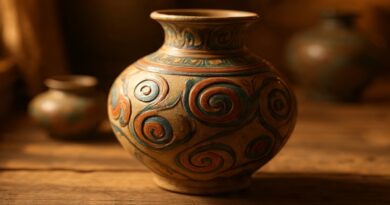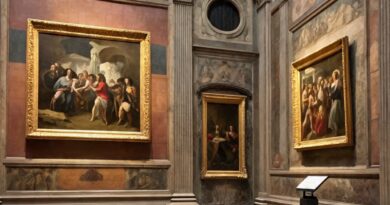The Role of Art inPreserving Heritage
Art has always been a mirror of human civilization, capturing the essence of cultures, traditions, and values that define societies. The role of art in preserving heritage is one of the most powerful ways through which communities keep their identity alive. Whether through paintings, sculptures, music, or architecture, art tells the stories of our ancestors, reminding future generations of where they came from. It is not merely an expression of creativity—it is a living bridge between the past and the present.
The Role of Art in Preserving Heritage Through Visual Representation.
One of the most significant aspects of the role of art in preserving heritage lies in its visual storytelling. From ancient cave paintings to modern digital artworks, visuals serve as historical documents that narrate the life, beliefs, and emotions of people from different eras. For instance, the Mughal miniature paintings of South Asia or the ancient murals of Egypt offer a glimpse into royal lifestyles, wars, and religious practices. These artistic expressions go beyond aesthetics—they become a form of cultural record-keeping that transcends language and time.
The Role of Art in Preserving Heritage Through Architecture
Architecture is perhaps the grandest and most enduring form of art. The magnificent mosques, temples, cathedrals, and palaces around the world are not just structures—they are artistic masterpieces that embody the identity of their civilizations. The Taj Mahal in India, the Badshahi Mosque in Pakistan, and the Pyramids of Giza in Egypt all serve as testaments to the role of art in preserving heritage. These structures are tangible symbols of the beliefs, craftsmanship, and technologies of their time, preserved for centuries through artful design and construction.
The Role of Art in Preserving Heritage Through Performing Arts
Performing arts such as dance, music, and theater have also played a vital role in keeping traditions alive. Folk dances, traditional music instruments, and classical dramas often reflect the stories and values passed down through generations. For example, the Kathak dance in India or the Attan dance in Afghanistan are not just performances—they are living embodiments of cultural identity. Through such performances, the role of art in preserving heritage becomes a dynamic process where history is re-lived with every movement and sound.
The Role of Art in Preserving Heritage Through Literature and Calligraphy
Written art—whether in the form of poetry, literature, or calligraphy—has long been a cornerstone of cultural preservation. Historical manuscripts, sacred texts, and handwritten letters have carried the wisdom, philosophy, and traditions of civilizations for centuries. The Arabic calligraphy adorning Islamic architecture or the ancient scripts of East Asia demonstrate the role of art in preserving heritage through written beauty. Each stroke, letter, and word reflects not just meaning but the soul of an era.
The Role of Art in Preserving Heritage in the Digital Age
In today’s digital world, the preservation of culture through art has taken a new form. Digital artists, filmmakers, and photographers are using technology to document and recreate cultural experiences. Virtual museums, online exhibitions, and digital archives make heritage accessible to global audiences. Through modern innovation, the role of art in preserving heritage continues to evolve, ensuring that even as societies modernize, their roots remain visible and respected.
The Role of Art in Preserving Heritage Through Education
Art also plays an essential role in educating new generations about their cultural roots. Schools, universities, and museums often use artistic expressions to teach history and heritage. When children paint historical scenes or participate in traditional performances, they develop a deep emotional connection with their culture. Thus, the role of art in preserving heritage is not only about storing the past—it is about passing it forward through learning and experience.
The Role of Art in Preserving Heritage Across Borders
Heritage is not confined to one region or people. Through art, cultural understanding and appreciation cross borders. Exhibitions, cultural festivals, and international collaborations allow people to experience the beauty of other traditions. When art travels, it promotes unity and mutual respect. This global exchange highlights the role of art in preserving heritage on an international scale—showing that while our expressions may differ, the human desire to protect our identity remains universal.
The Role of Art in Preserving Heritage as a Form of Resistance
In times of political or social oppression, art often becomes a form of resistance. Communities use it to reclaim their history and identity. Street murals, protest songs, and folk storytelling are examples where the role of art in preserving heritage becomes a voice against erasure. When cultures are threatened, artists step forward as protectors of memory, ensuring that their traditions survive even in adversity.
The Role of Art in Preserving Heritage for Future Generations
Ultimately, the most powerful aspect of the role of art in preserving heritage is its timelessness. Art connects generations—past, present, and future—in a continuous dialogue. When a young person views an ancient sculpture or listens to a traditional melody, they are not just consuming art; they are inheriting a piece of history. Through this emotional and cultural exchange, heritage lives on, carried by the creative spirit of humanity.
Conclusion
In conclusion, the role of art in preserving heritage is far greater than mere decoration or entertainment—it is a vital thread that weaves the story of humanity. Art keeps history alive, celebrates cultural diversity, and ensures that future generations understand their roots. Whether carved in stone, sung in rhythm, painted on canvas, or captured in pixels, art remains the most beautiful and enduring guardian of heritage. As long as art exists, the legacy of human civilization will never fade.




Pingback: Ancient Art Forms That Still Inspire Today. Exploring the Timeless....